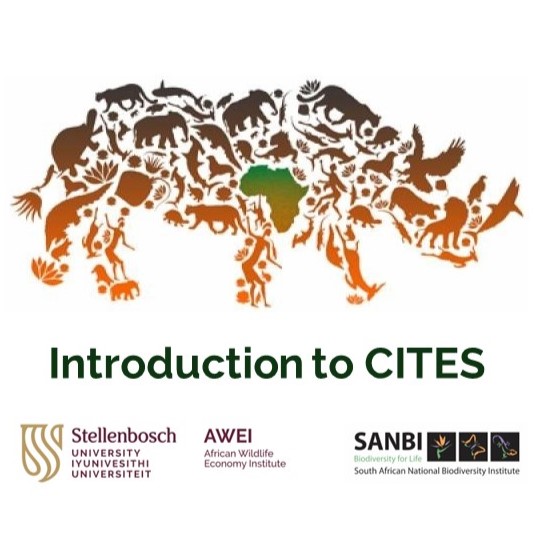CITES Module 8
8 Key elements of an NDF study
In this module you will learn about the role of Non-Detriment Findings (NDFs) as a CITES trade measure and approaches to undertaking an NDF study by a CITES Scientific Authority.
Lecture
- Click on the image below to stream the lecture on OneDrive (13 min)
- You can also download the lecture for listening offline
- Take notes while listening
What is an NDF?
- A non-detriment finding (NDF) is a conclusion made by a Scientific Authority that the export of specimens of a particular species will not impact negatively on the survival of that species in the wild
- It signifies that harvesting specimens for trade is biologically sustainable
- A non-detriment finding is a decision that can take many forms; e.g.
- Written advice from the Scientific Authority
- Verbal advice from the Scientific Authority
- A quota agreed by the Scientific Authority for a specific time period
Learning resources - videos
- While watching these videos, reflect on the learning questions provided
- Take notes while viewing
Supporting Sustainable Trade of CITES Species
- The Commission for Environmental Cooperation (CEC) project Supporting Sustainable Trade of CITES Species is bringing together experts from Canada, Mexico and the United States to promote the sustainable trade of four North American CITES Appendix II species groups: sharks, tarantulas, turtles and tortoises, and timber.
- Q: This video presents a continental approach to enabling sustainable trade of CITES listed species? Could something like this be done for Africa or a subregion of Africa?
What is CITES and how does it work?
- The CITES Scientific Support Officer explains what the convention is and how it ensures that wildlife trade is legal, sustainable and traceable.
- Q: The video mentions a role of an NDF for CITES permits. What is it and what roles are not mentioned?
e-NDF software for CITES sharks and rays
- This tool has been designed specifically for sharks and rays but can be adapted for any other CITES-listed species group or used as a management tool for non-CITES listed species.
- Q: What are some particular useful features of this software for producing NDFs?
 Learning resources - readings
Learning resources - readings
- While skimming through these documents, reflect on the learning questions provided
- Also, download documents for future reference
Role of CITES Management Authorities.ppt
- CITES presentation
- Q: What, if anything, in this presentation differs from your understanding of the role of the Management Authority?
Role of CITES Scientific Authorities.ppt
- CITES presentation
- Q: What, if anything, in this presentation differs from your understanding of the role of the Scientific Authority?
Understanding Non-detriment Findings.ppt
- CITES presentation
- Q: What, if anything, in this presentation differs from your understanding of the the purpose of NDFs?
- This publication presents the background to the development of the non-detriment finding checklist and explains how the checklist itself is designed to work, in the hope that Scientific Authority staff will take and develop the parts of the approach that they find useful.
- Q: This guidance has been used by the Scientific Authority in South Africa? What are the two or three key variable for determining whether trade would be sustainable of detrimental?
CITES Non-detriment Findings Guidance for Perennial Plants
- This Guidance, designed to build on previous milestones, describes a nine-step process enabling Scientific Authorities to make NDFs that are science-based, using information with data quality appropriate to the severity of conservation concerns, intrinsic biological risks, harvest impacts, and trade impacts identified for the species concerned.
- Q: What elements, if any, are particularly relevant for wild plants and maybe not so relevant for wild animals?
Methodology for drawing up non-detriment findings for CITES species
- The development of this methodology has also been motivated by the recently adopted EU Action Plan against Illegal Trafficking (COM (2016) 87 final)2 , which establishes among its objectives to ensure a more uniform application of EU trade rules on the wildlife trade, through better enforcement and compliance monitoring by Member States.
- Q: Though this guidance has been developed for European Union member states, could it also be applicable or replicable for African Union member states?
Determining the sustainability of legal wildlife trade
- We propose a more precautionary approach to wildlife trade and monitoring that requires those who profit from trade to provide proof of sustainability.
- Q: How does 'proof of sustainability' differ from 'non-detriment' and how would this approach impact on the role of the Scientific Authority?
 Learning resources - websites
Learning resources - websites
- While browsing these websites, reflect on the learning questions provided
- Also, bookmark websites for future reference
Non-detriment findings | CITES
- This is main page on the CITES website for NDFs. It contains links to a good deal of information.
- Q: In the sections on the history of NDFs and current policies, can you list three ponts that are particularly relevant to the work of the Scientific Authority in South Africa?
Course: Introduction to CITES and Non-Detriment Findings (unia.es)
- This course offers an introduction to what is usually called a non-detriment finding (NDF). Many researchers and observers of the Convention have called NDFs the heart of CITES and one of its very unique characteristics.
- Q: If you decide to enrol in this course, can you list three key insights for NDFs in South Africa?
- The 9-Steps can be applied for any species of either perennial plant or timber.
- Q: As you look through this website and maybe even enrol in one of the online courses, should this be replicated for animal species and if so what would be different?
CITES Workshop on Non-Detriment Findings – Dec 2023
- Webpage for a global meeting for CITES Parties and qualified observers to develop NDF guidance.
- Q: Click one of the modules. What is of particular interest and even relevance in this module for NDFs in South Africa?
- A database for sharing NDF materials.
- Q: Can you find documents which may be useful for undertaking an NDF study in South Africa?
NDF Support Tool (unep-wcmc.org)
- Launched in March 2024, it is an interactive online tool that allows users to search by CITES-listed species and country/territory combinations, and explore data relating to the species’ conservation status, distribution, trade level, threats and life history.
- Q: Select one listed animal and one listed plant native in South Africa. Is thhe information provided useful for undertaking an NDF study and, if so, how?
Let's continueGo to Module 9 Application of CITES measures in South AfricaGo back to Module 7Go back to the introduction |
Get updates by email
Through impactful research, stakeholder engagement, and professional development, AWEI is supporting the wildlife economy across Africa. Please subscribe for occasional updates on our work and forthcoming events.
Sign up for a quarterly dose of AWEI insights
In a complex and changing world, AWEI generates strategic ideas, conducts independent analysis on wildlife economies, and collaborates with global scholar-practitioners to provide training and expertise for biodiversity conservation, climate resilience, and inclusive economic opportunities in Africa.

